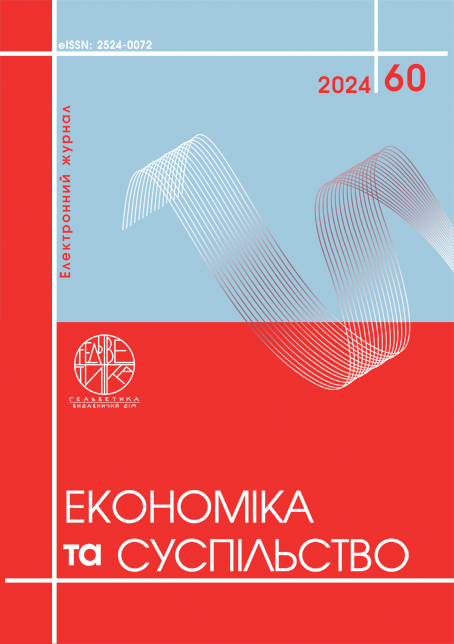MECHANISMS OF INNOVATIVE COOPERATION OF ENTERPRISES IN HIGH-TECH INDUSTRIES IN THE CONDITIONS OF WAR CHALLENGES
Abstract
The article reveals the mechanisms of innovative cooperation that are relevant at present time for enterprises that are the part of the national military-industrial complex, namely: clusters, networks, consortia, platforms, ecosystems. It is determined that clusters are the most popular and well-studied mechanism of innovative cooperation, although there are also skeptical views in the scientific community about the possibilities of usage clustering to increase the innovativeness of high-tech industries. Nevertheless, many scientists consider the cluster mechanism to be the main platform for scaling up innovations in the high-tech sector. The mechanism of “innovation networks”, which is generally considered the basis for the development of the high-tech sector of the state's economy is represented. It is noted that “innovation networks” can include any association based on contract or “partnership” or “intentions” agreements, which means the updated concept of the mechanism. It is noted that innovative, scientific and technical, research and production consortia are built on the basis of contracts concluded between a number of entities, with the operations of the innovation cycle assigned to them. The mechanism of innovative cooperation in the format of a consortium has a closed composition of participants whose relations are determined by the contract. It is localized within a single but long-term innovation project; the economic effect for participants is the share of profit after commercialization of innovation. It is emphasized that the mechanism of “innovation platforms” appeared as a result of the creation of global technological standards by the leaders of high-tech industries, and the platform itself is a technological standard, in the development and scaling of which the leader is primarily interested. The concept of “ecosystem” is revealed in the article. It is substantiated that this concept in the economy can be treated as a group of strategically interconnected enterprises with a single technological platform of development and production cycles, which are simultaneously united in the value chain. At present, innovation ecosystems are considered to be the highest organizational form of cooperation among other mechanisms of innovative cooperation (platforms, networks, clusters). The essence, organizational content and effectiveness of application of these mechanisms in the innovation cycle are revealed in the article. A comparison of the mechanisms from the point of view of organizational and economic characteristics is proposed. Attention is focused on the need to deepen the study of “innovation ecosystems”.
References
Про інноваційну діяльність : Закон України вiд 04.07.2002 р. № 40-IV (в редакції від 31.03.2023 р. підстава - 2849-IX) https://zakon.rada.gov.ua/laws/show/40-15#Text (дата звернення 12.03.2024 р.)
Пропозиції Асоціації «підприємств промислової автоматизації України» (АППАУ) та руху 4.0 до Національної економічної стратегії 2030. https://www.industry4ukraine.net/publications/propozycziyi-appau-ta-ruhu-4-0-do-naczionalnoyi-ekonomichnoyi-strategiyi-2030/ (дата звернення 13.03.2024 р.)
Січкаренко К.О. Мережева організація інноваційної діяльності: Наукова доповідь. Київ: ДУ "Інститут економіки та прогнозування НАН України". 2015. http://ief.org.ua/docs/sr/289.pdf (дата звернення 15.03.2024 р.)
Belussi, F., Orsi, L. Innovation, alliances, and networks in high-tech envi- ronments. Innovation, Alliances, and Networks in High-Tech Environ- ments, 66, 2015, pp. 1-359
Duranton G., Puga D. Microfoundations of urban agglomeration economies. In Vernon Henderson and Jacques Fran/Iois Thisse (eds.) Handbook of Re- gional and Urban Economics, volume 4. Amsterdam: North Holland, 2004.
Etzkowitz, Н. Silicon Valley at risk? Sustainability of а Global Innovation Icon: Ап IntroduGtion to the Special Issue. Soc. Sci. Inf. 2013, 52, 515-538.
Etzkowitz, Н., Leydesdorff, L., The Triple Helix University-Industry-Government Relations: А Laboratory for Knowledge Based Economic Development (January 1. EASST Review, Vol. 14, No. 1, pp. 14-19, 1995.
Jarunee W. Commercialization Strategies of Technology: Lessons from Silicon Valley. J. Technol. Transf. 2010, 2, 225-236.
Jaruzelski B. Why Silicon Valley's Success Is So Hard to Replicate»). https://www.scientificamerican.com/article/why-silicon-valleys- success-is-so-hard-to-replicate/ (дата звернення 11.03.2024 р.)
Pro innovatsiinu diialnist : Zakon Ukrainy vid 04.07.2002 r. № 40-IV (v redaktsii vid 31.03.2023 r. pidstava - 2849-IX) [On innovative activity: Law of Ukraine dated 04.07.2002 No. 40-IV (in the version dated 03.31.2023, basis - 2849-IX)] Available at: https://zakon.rada.gov.ua/laws/show/40-15#Text (accessed 12.03.2024 r.)
Propozytsii Asotsiatsii «pidpryiemstv promyslovoi avtomatyzatsii Ukrainy» (APPAU) ta rukhu 4.0 do Natsionalnoi ekonomichnoi stratehii 2030. [Proposals of the Association of "Industrial Automation Enterprises of Ukraine" (APPAU) and the 4.0 movement to the National Economic Strategy 2030.] Available at: https://www.industry4ukraine.net/publications/propozycziyi-appau-ta-ruhu-4-0-do-naczionalnoyi-ekonomichnoyi-strategiyi-2030/ (accessed 13.03.2024 r.)
Sichkarenko K.O. (2015) Merezheva orhanizatsiia innovatsiinoi diialnosti: Naukova dopovid. [Network organization of innovative activity: Scientific report.] Kyiv: DU "Instytut ekonomiky ta prohnozuvannia NAN Ukrainy". Available at: http://ief.org.ua/docs/sr/289.pdf (accessed 15.03.2024 r.)
Belussi, F., Orsi, L. (2015) Innovation, alliances, and networks in high-tech envi- ronments. Innovation, Alliances, and Networks in High-Tech Environ- ments, 66, , pp. 1-359
Duranton G., Puga D. (2004) Microfoundations of urban agglomeration economies. In Vernon Henderson and Jacques Fran/Iois Thisse (eds.) Handbook of Regional and Urban Economics, volume 4. Amsterdam: North Holland.
Etzkowitz, N. (2013) Silicon Valley at risk? Sustainability of a Global Innovation Icon: Ap IntroduGtion to the Special Issue. Soc. Sci. Inf., 52, 515–538.
Etzkowitz, N., Leydesdorff, L. (1995). The Triple Helix University-Industry-Government Relations: A Laboratory for Knowledge Based Economic Development (January 1. EASST Review, Vol. 14, No. 1, pp. 14–19).
Jarunee W. (2010) Commercialization Strategies of Technology: Lessons from Silicon Valley. J. Technol. Transf., 2, 225–236.
Jaruzelski B. Why Silicon Valley's Success Is So Hard to Replicate»). https://www.scientificamerican.com/article/why-silicon-valleys- success-is-so-hard-to-replicate/ Available at: (accessed 11.03.2024 r.)

This work is licensed under a Creative Commons Attribution 4.0 International License.


